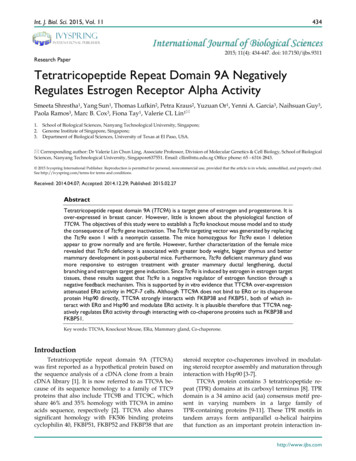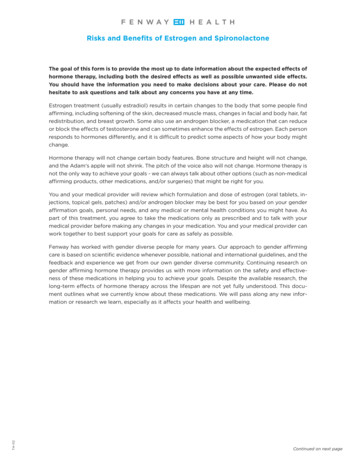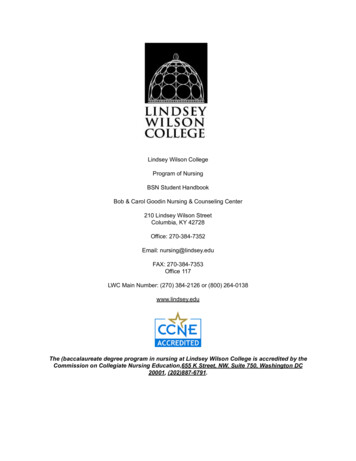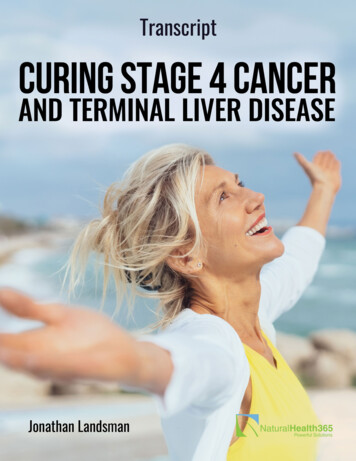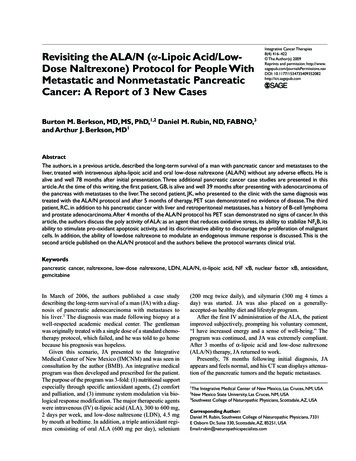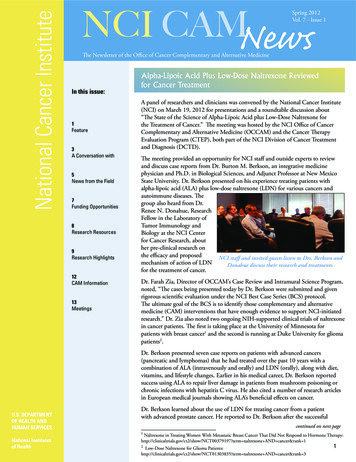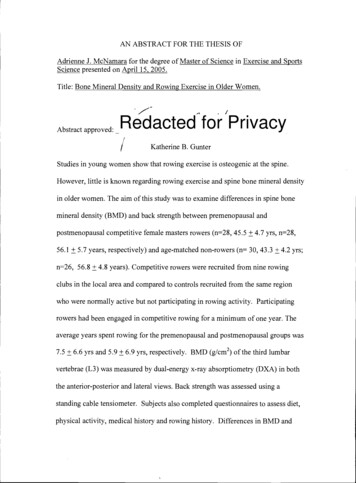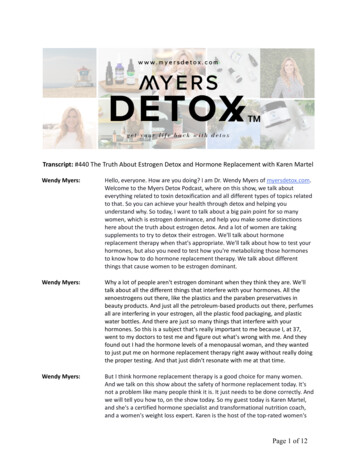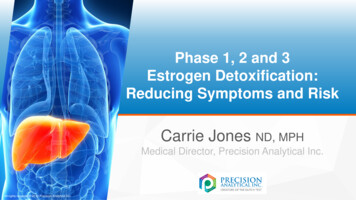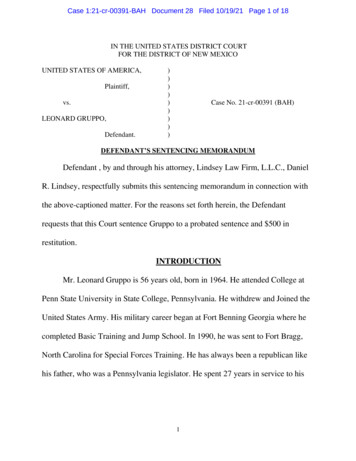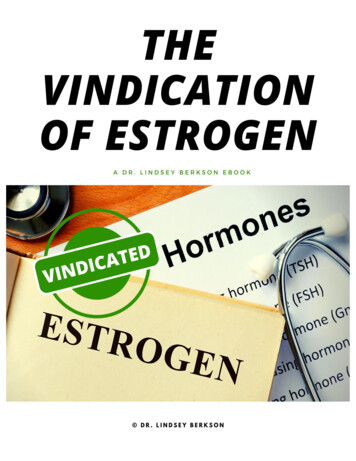
Transcription
Estrogen Vindicated – Dr. D. Lindsey BerksonStunning 19-year follow-up of the Women’s Health Initiative proves, once and for all,that estrogen protects against breast cancer.SummaryEstrogen was once a popular hormone, used as an anti-aging drug and even to treat breastcancer, but after the massive Women’s Health Initiative1 (WHI) study’s first negativepublications (July 9, 2002), many doctors and women became estrogen-phobic. However, afew years of very early re-analysis2 3 4 5 6 7 8 9 10 11 12 13 14 of the WHI’s data revealed lots ofstatistical problems that challenged these original conclusions. But that information nevermade headlines like the initial “bad news” did.What was the bad news? That estrogen could cause breast cancer.Now there has been a long time for scientists to reevaluate the data. Almost two decades.A 19-year reanalysis15 makes it clear that estrogen is not the enemy; rather, it protectsbreasts from cancer. Unfortunately, most doctors still haven’t gotten the good news.Even though no one knows exactly how breast cancer starts, it does not seem to be due toestrogen, but rather to cancer stem cells—a totally different kind of cell that has nothing todo with estrogen. Most older women, who naturally have less estrogen, have higher risks ofbeing diagnosed with breast cancer than younger more estrogenized females. Pregnancy,which is the highest estrogen time of life in any woman, is protective against breast cancer.Medical folks thought tamoxifen worked because it was an anti-estrogen, but tamoxifenworks in various ways, not just by tamping down estrogen. In fact, tamoxifen can oftenraises estrogen levels. In the HABITs study (which concluded that hormones cause breastcancer), only the women on tamoxifen turned out to have higher risk of recurrences(though this was not easy to read in the depths of the study).Recent studies have shown that estrogen protects the breast as well as safeguarding thebody in many other ways. The appreciation of how estrogen is foundational in protectinghealth is rapidly growing. A few examples are that estrogen protects bones from fracture16,blood vessels from hardening17, brain from dementia18 19, shields mitochondria (energyproducing cells) from damage, 20 allows our bodies to benefit from lifestyle changes as itpromotes epigenetics21, makes it easier to keep a smaller waist22, and maintains heart23and kidney24 25 26 health. It is as close to an effective anti-aging tool as we have, maintaininglife-promoting telomere length.27Estrogen is not the causative factor in breast cancer, in fact, it protects against breastcancer and dementia while reducing premature death from diverse causes.2
Estrogen Vindicated – Dr. D. Lindsey BerksonMy StoryTwenty-six years ago I was diagnosed with breast cancer. This was not found bymammogram but by self-palpation while in the shower. I was the very first woman in theU.S. diagnosed with a pure mucinous cancer, a very rare cancer back then, more commonnow. Neither my radiologist nor oncologist had every treated a pure mucinous cancer atthat time.I was a DES (diethylstilbestrol) daughter, meaning my mother had been given this drugwhen pregnant with me. DES was banned in 1971 as the most cancer-causing substanceever invented at that time. DES was the first synthetic estrogen (50 times stronger thanbio-available estrogen) and given to pregnant women from 1938 to 1971 as a prenatalvitamin or to stop threatened miscarriages. Many DES daughters turned out to manifestbreast cancer in their mid-40’s. I was one of the very first ones.As no one had ever treated breast cancer in a DES daughter before, I kept asking, “How doyou know that what you are recommending is right for me?”They suggested I do standard protocol, like radiation. However, even though my doctorshad never treated pure mucinous tumors before, or ever treated a documented DESdaughter before, after several weeks of sleuthing (pre-Internet), I found the only twogroups (in the Netherlands) with human studies at that time on this type of tumor.Due to the time changes, I had to call the principal leaders on these investigations in themiddle of the night and leave messages about my circumstance. As the fickle finger of fatewould have it, one head investigator didn’t call me back until a very dramatic moment: Iwas sitting on the table getting the grid put on my chest for my first radiation treatment.This doctor/scientist firmly recommended, “If I were you, I would not do radiation. Wehave learned that radiation causes fibrosis, which makes it impossible to palpate a tumor inthe breast if cancer returns. Totally pure mucinous tumors are never picked up bymammograms, only by palpation. If you have radiation, you won’t be able to monitoryourself appropriately. That’s what we advise all our pure mucinous breast cancer patientsto do: not get radiation and do vigilant breast exams.”I got off the table and told the radiologist I wasn’t going to do radiation therapy.I explained to this female radiologist (wife of one of the local cancer docs) what theexperienced researcher had told me. I further explained that this scientist was one of theonly two research teams in the world (at that time) studying this unique tumor type. Theyhad published a study on 95 patients with this unique tumor28, and understood protectivedetails for patients with this unique tumor.The radiologist spat angrily back, “F him!” (I kid you not.) “If you don’t do this radiation,you are certainly going to die!”That was 26 years ago.Then my cancer doctors told me that I didn’t need chemotherapy. Hmmm. Reading thescience, it was becoming clearer to me (even way back then) that stem cells caused cancer3
Estrogen Vindicated – Dr. D. Lindsey Berksonmore than the daughter cells found mostly in primary tumor loads. I decided to do my ownchemo. After a lot of investigation, I found a black market chemo from Switzerland (called“Ukraine”) that was supposed to eradicate both daughter cancer cells and cancer stem cells,but not harm healthy cells.So I did 40 rounds of this chemo with a willing local doctor.Then my cancer doctors recommended tamoxifen.But I was one-of-a-kind—a lone woman with a pure mucinous tumor and a history ofDES—so it seemed they didn’t really know if it would help me and this special situation or not. They were fitting me into the same box that all other breast cancer patients were in.So I called Craig Jordan, the man who put tamoxifen on the map. Grateful to get him on thephone, I asked: “I have this rare tumor and this rare in-utero exposure to DES. Do you thinkI’m really a candidate for tamoxifen?”Dr. Jordan was thoughtful and candid, “I have to be honest with you. No one in yoursituation has ever asked me that. Let me look into this. I’ll get back to you in a week.”To his credit Dr. Jordan indeed called back within a week and humbly explained, “If I wereyou, I wouldn’t take tamoxifen. I think it might make DES daughters worse. Not sure, but Idon’t have a good feeling about it.”Stunningly enough, I still get yelled at by cancer doctors today telling me I made a mistakenot taking it, even though its main scientist suggested otherwise!After all I read, it made sense to me to take estrogen therapies, even though not one of mycolleagues (functional or conventional) agreed with me. I was on my own. I waited fiveyears just to be safe, but at year six Dr. Wright wrote me the first bioidentical script for 2methoxyestradiol (2 MEO), which I had figured out would reverse the immunosuppressiveissues started by DES in the womb. I was the first person in the U.S. to take bioidentical 2MEO, so Dr. Wright and I had to figure out the dosage.I also began hormonal therapies of estradiol, estriol, progesterone, and testosterone.When I saw my breast cancer doc for yearly exams over the past two decades, she wouldsay, “You look better than any of my other patients. But stop taking estrogen. It will killyou.”Thank god, I’ve been well. At my ripe age, when many are winding down, I’m still windingup. My breast cancer doctor is 20 years younger than I am, but truthfully, as smart and niceas she is, she looks 20 years older as she hasn’t taken hormone therapies.This 19-year reanalysis of the Women’s Health Initiative confirms my own research. (Forthose who want to know, I take 125 mcg /2MEO methoxyestradiol/day, along with .35 mgestradiol/.75 mg estriol BID labially, along with 3 mg testosterone/day mucosally.)By the way, there are a lot of nuances to taking 2 MEO. I have a webinar on it available atdrlindseyberkson.com. It’s hard to get. I am trying to write the monograph that the FDArequires to help move this along.4
Estrogen Vindicated – Dr. D. Lindsey BerksonI worked at a hormone/nutritional family practice clinic, the Wiseman Family Practiceclinic, in Cedar Park, TX, for six years. I asked Dr. Richard Wiseman, who had been inpractice for almost 50 years, what he thought about hormones. He ran several Ironmanmarathons a year, looked like he stepped out of an Irish Spring commercial, and had beenprescribing bioidentical hormones all those years. Dr. Wiseman said, “If you took 100people who all exercised and ate well, you could still pick out those who were onhormones: they will have shinier skin, more youthful voices, straighter posture, thinnerwaistlines, look younger, and even appear more confident.”Hormones protect so many organs—from the collagen in our skin to the volume of ourhippocampus (where our memories live in the brain).I am honored to be able to write this article to spread the word that the science showsestrogen is once again okay to prescribe and safe to take.ESTROGEN VINDICATEDEstrogen has had a bad rap for over 20 years.Many women, upon hearing the word “estrogen,” unconsciously cover their breasts withtheir arms in worry. Estrogen makes them think of the enemy — breast cancer. Women,physicians, and scientists alike have come to equate estrogen with being a tricky andpotentially dangerous player. And many contemporary doctors and oncologists regardestrogen as fuel for breast cancer.This is understandable when you look at the history of estrogen and the uterus. As womenwere being prescribed estrogen to achieve staying “feminine forever,” in the 1970s theincidence of cancer of the uterus suddenly increased four to eight times more in womentaking estrogen therapies versus ladies who were not taking it29.It was soon figured out that estrogen replacement was causing the lining of the uterus to“grow out of control”—the hallmark for cancer. This estrogenic potentially-cancerous effectwas then entirely controlled by adding synthetic forms of progesterone, called progestins,to estrogen scripts. The progestins successfully blocked overgrowth and warded off theuterine cancer. The spike in uterine cancer in women taking estrogen stopped.(Bioidentical progesterone was also shown to protect the uterus from estrogen30 31 32. )Thus, the standard of care by many mainstream doctors has been to prescribe a combotherapy of estrogens plus progestins in women that still have a uterus.It then seemed like an intuitive leap to the idea that progestins would have the sameprotective effect at the breast. Thus, many women have been prescribed a combination ofestrogen and progestins as hormonal therapy, thinking the progestins were protecting boththe uterus and the breast.This turns out not to be the case.5
Estrogen Vindicated – Dr. D. Lindsey BerksonEstrogen’s Roller Coaster HistoryFor over 40 years, estrogen therapies were the biggest-selling pharmaceuticals inpharmaceutical history. Women were prescribed estrogen therapy, without any largerandomized studies proving that estrogen therapies were helpful or safe (although thePEPI studies33 were a smaller randomized study run on 847 women that showed thatwomen on estrogen for over three years had better heart health without a rise in bloodpressure or issues with insulin).For decades doctors and patients felt that estrogen kept women “feminine forever.”Up until 2002, estrogen was the recommended standard of care for menopause. Everyonewas on board the estrogen train. Prestigious medical journals, respected researchinstitutions, and recognized expert cancer doctors all accepted the idea that estrogen wassafe for breasts and that estrogen did NOT increase the risk of breast cancer.Researchers were concluding that women taking hormone therapy were less likely todevelop breast cancer. In 1987, a consensus conference reported in the British MedicalJournal: “Well-defined epidemiological studies of estrogen therapy do not suggest anoverall increase in the risk of breast cancer in postmenopausal women34.” These resultswere replicated. This is the hallmark of great science—independent labs demonstrating thesame results. A multi-centered report even found that women with the dangerous breastcancer genetic glitch, the BRAC1 gene, had no increased risk of breast cancer when onhormone therapies for an average of 4.3 years35.You heard about Angelina Jolie having both her breasts removed because she has theBRAC1 genetic mutation. Women with this genetic mutation are at a greater lifetime risk ofbreast cancer (as well as many other cancers) than women without this glitch. But amedical oncologist at the Sunny-brook Regional Cancer Center in Toronto studied 472BRCA1-positive postmenopausal women, half of whom were taking hormones and half not.She concluded that “among postmenopausal women with a BRCA1 mutation, estrogen use,averaging four years, was not associated with an increased risk of breast cancer; in fact, inthis population, it was associated with a significant decreased risk36.” (I wrote about thisprotective effect of estrogens in BRCA1 breast cancer patients in Safe Hormones, SmartWomen.37 )In a 1993 editorial in the New England Journal of Medicine, two endocrinologists fromHarvard stated, “On the basis of the available evidence, we recommend that allpostmenopausal women be considered for hormone replacement therapy and be educatedabout its risks and benefits38.”Study after study found no consistent increased risk of breast cancer in women who tookestrogen for five years, ten years, or 15 years39. A later Japanese study on 9,000 womenreplicated this data40.6
Estrogen Vindicated – Dr. D. Lindsey BerksonThrough the 20th century, it was well accepted that estrogens did not cause breast cancer.However, the Women’s Health Initiative prematurely stopped of one of the hormone studygroups in July 2002.Then everything changed.The Women’s Health Initiative (WHI)The NIH started the WHI because Americans are getting older and sicker at a rapid rate,and the NIH wanted to know how to protect aging women while not toppling Medicare.How old are we getting? The 65 and over population is projected to more than double from6.4 million in 2016 to 14.6 million in 2040 (a 129% increase). By 2060 there will be over98.2 million Americans over the age of 65. To try to protect Medicare from being unable tohandle this enormous health care load, the Women’s Health Initiative 41 42 was set intomotion.The Women’s Health Initiative (WHI) was organized by the U.S. National Institutes ofHealth in 1992 to study the health of postmenopausal women and was scheduled to becompleted in 2007. The WHI was a series of a group of studies looking at aging womenevery which way. To date, WHI has published over 1,400 articles and funded 289 relatedresearch trials looking at various aspects of health, such as diet, bone health and nutrients,heart health, the effect of sitting on hormones and the risk of hormone-driven cancers, and,of course, very large randomized trials looking at hormone therapies.From 1993 to 1998, the WHI enrolled 161,809 women aged 50-79 years at 40 differentclinical centers.The WHI wanted to create the first very large randomized studies on hormones. Everyonewho was part of running the trials assumed the results would prove what years of givingestrogen to millions of women and previous trials had shown (though not in largerandomized scientific manner): that estrogens slowed down aging and kept womenyounger for longer.At 40 centers nationally, researchers ran two different groups of hormone trials, called“arms”—one with women given only estrogen and the other arm given estrogen andsynthetic progesterone. Premarin, a form of estrogen found in horse’s urine, was theestrogen used in the study. The other arm gave women Premarin plus a synthetic progestin.July 9, 2002—a fateful day for hormones. Before the studies were supposed to end, at thefive-year mark, the regulatory Data and Safety Monitoring Board recommended both armsof the study be stopped. This premature decision was not unanimous; some boardmembers wanted to stop the study and others didn’t.This was based on results from the combo hormone study arm (synthetic progestins estrogen), which showed, at five years of follow-up, a statistically significant increase ininvasive breast cancer and an increase in heart disease adverse events.7
Estrogen Vindicated – Dr. D. Lindsey BerksonAt first blush, it looked like women on hormone replacement were at higher risk of gettingthe very diseases that hormones were supposed to protect against. Many were shocked. Itlooked like hormones were causing the very issues they were being prescribed to prevent.Huge numbers of doctors in the U.S. stopped writing scripts for hormones. In Europe, thisdidn’t happen as much; European doctors tend to write scripts for natural hormones orestriol, the anti-cancer estrogen, a lot more often.Doctors and patients alike started to think of estrogen as the enemy. (If you want an indepth, easy-to-read, detailed account of this whole unfolding, read Safe Hormones, SmartWomen.)43Due to the results of the WHI study, estrogen was getting blackballed.Both arms of the study were finally officially stopped on February 2, 2004.However, by this time, 2004, re-analysis by the monitoring committee was demonstratingdifferent results than the mostly negative ones from two years earlier: Hormone therapies were being linked to increased risk of stroke. But this increasewas very small and almost half the women had dropped out of the study, so therewere a lot of statistical issues44 and respected experts were questioning thestatistical significance, a trend toward dementia, no increase or decrease of coronary disease, a reduction in bone fractures and no increased risk of breast cancer. (This fact has not gotten out to the public or todocs, and was buried on page 18 in one small paragraph of the 2004 re-evaluation.)In fact, Dr. Leon Speroff, the iconic gynecologic physician who authored the predominantbook that most gynecologists and obstetricians are trained with (Clinical GynecologicEndocrinology and Infertility) and long-time professor at the University of Oregon,concluded in 2005 and again in 2008 that the 2004 results did not demonstrate the samenor agree with the first 2002 monitoring board statements.After looking at every statistical nuance of the WHI, Dr. Speroff said 45 46: “Long-termpostmenopausal hormone therapy is not precluded by the results reported by the WHI.There continues to be good reason to believe that there are benefits associated withtreatment, including improvement of quality of life beyond the relief of hot flushes,maximal protection against osteoporotic fractures, a reduction in colorectal cancers,maintenance of skin turgor and elasticity, and the possibility of primary prevention of CHDand Alzheimer’s disease.”Dr. Speroff clearly said that the WHI did not show an increased risk of breast cancer. Isummarized the issues of the WHI in Safe Hormones Smart Women:8
Estrogen Vindicated – Dr. D. Lindsey Berkson Women in the second group on horse estrogen had less breast cancer. After 7.1years on horse estrogen itself (without synthetic progestins), they had 18 to 44%less breast cancer depending on the re-analyses you read47. Breast cancer(localized to breasts) was reduced by 31% and ductal breast cancer was reducedby 29%48 49. A 10-year follow-up said the decreased incidence of cancer was persisting up to 10years, even with an average of 5.9 years only of using estrogen50. Now persistentbenefit is being noted up to 19 years. There was an apparent protective effect of the horse estrogen on breast cancerincidence in all categories for women at lower risk (who didn’t have first-degreerelatives with breast cancer or fibrocystic breasts). Women who had been on synthetic progestins in the past (before this estrogenonly study) were at greater risk. Those on estrogen only before this study did nothave increased risk. After 7.4 years of estrogen only, younger women (50 to 59 years of age),monitored by sophisticated imaging studies, actually had slower growth ofcalcified plaque in their arteries, meaning they had a heart-protective effect fromthe estrogen 51 52 53.In an article titled “Women’s Health Initiative is Fundamentally Flawed,” the authors (fromLoyola University Stritch School of Medicine) said that the WHI findings were wrong. Theysummarized quite a large number of colleagues and experts challenging the WHIconclusions.Fred Naftolin PhD., a scientist from Yale who was also on the executive committee of theInternational Menopause Society, was worried that doctors were denying women a chanceto take estrogen and as a result were withholding preventative care, especially for theirpatients’ hearts. Heart disease is the number one killer of women, not breast cancer54.Other re-analyses by respected well-known statisticians were also showing that women inthe estrogen-only arm had 33 to 44% less risk of breast cancer.But these positive reports failed to make headlines55 56. Doctors and patients were nothearing the good news. The revised news. It’s been shown by a shocking multi-centeredstudy, headed by Stanford’s Prevention Research Center, Department of Medicine, that oneout of three randomized trials, when re-analyzed57, come out different, often making thefirst conclusions wrong and thus, recommendations to patients, wrong.But it’s the first scary (even if wrong) “loud” conclusions that make headlines. These areespecially difficult to get out of the medical and cultural consciousness.Especially if litigation is involved.9
Estrogen Vindicated – Dr. D. Lindsey BerksonRight after the first scary (and repeatedly found wrong) warnings about hormone therapiescame out, Wyeth was sued by 6,000 women and had to pay out billions of dollars. Betweenthe fear of the negative comments on hormones and the litigious atmosphere in the U.S.,hormone therapy drastically dropped.Money and fear of being sued had a lot to do with keeping the new and improved analysesfrom reaching women far and wide.Avoiding estrogen therapies for any kind of high-risk women became the standard of care.The sad reality is that up to the present time, many doctors, gynecologists, and patientscontinue to be frightened or highly reluctant to prescribe or use estrogen and estrogentherapies. Women at high risk for breast and other hormonally-driven cancers are told thatthey are not candidates for estrogen therapy.Summary of Criticisms of the WHI58 The design was flawed It only used one protocol of hormones (not individualized or diverse options) The age of the participants was older, many years away from hormone exposure The majority of women were obese (which is a significant risk factor for breastcancer) Extreme number of dropouts of participants The recommendations could not be validly generalized to all women Many of the conclusions were ultimately found to be inaccurate.Decline in Breast CancerOne of the clinchers in the media and even in scientific studies that the WHI’s conclusionswere sacrosanct, was the recent decline in breast cancer incidence. Many said, “See, aswomen went off hormones, they got less breast cancer. This proves the HRT-breast cancerlink.”I realized early on, about 2004 and 2005, that women were going to be missing out onhormones. Scouring the literature. I saw the reanalyzes that were not making headlinenews. I became passionate about getting the accurate science “out” so women wouldn’tmiss out on life-saving and breast-saving hormones. That’s why I wrote Safe Hormones,Smart Women. All the information inside that book has been vindicated.But as I took a deep dive into the incidence data, it became clear that breast cancer ratesstarted to slow down before the WHI results came out and use of HRT went down.10
Estrogen Vindicated – Dr. D. Lindsey BerksonThe conclusion that going off hormones secondary to the WHI started the decline in breastcancer incidence is wrong. But this is not known by many, doctors, patients, orpharmacists.Dr. Christopher L. Li, from the Division of Public Health Science at the Fred HutchinsonCancer Research Center59 (one of the cancer center names on the WHI 19-year reanalysis),looked at data from 13 cancer registries from 1995 to 2004 to get a handle on what wascausing lowering of incidence of breast cancer cases.They found that breast cancer rates started to go down around 1998, well before 2002when the WHI brouhaha hit the media. The decline, they stated, was mostly likely due tomore and improved breast cancer screening. The WHI didn’t start the decline, though itmay have contributed to it.WHI Details Up to 19 YearsFrom 1993 to 1998, more than 27,000 postmenopausal women, aged 50 to 79 years, withno prior breast cancer, enrolled in one of two randomized, placebo-controlled WHI trialsimplemented at 40 U.S. centers, with follow-up through September 2016. Women with an intact uterus received CEE (0.625 mg/day) plus MPA (2.5mg/day) or placebo (n 8102) for a median of 5.6 years. Women with prior hysterectomy received CEE alone (n 5310) or placebo (n 5429) for a median of 7.2 years. After about 19 years of follow-up, CEE MPA resulted in a significant 29%increased risk of breast cancer Whereas CEE alone resulted in a significant 23% reduction in breast cancerincidence. In terms of deaths from breast cancer: There was a significant 44% reduction with Premarin alone. There was a 45% increase (borderline significance) with CEE MPA (Premarin plusthe synthetic progestin MPA)The ReanalysisOn December 13, 2019, at the San Antonio Breast Cancer Symposium (SABCS), an abstractwas presented that summarized the 19-year follow-up of the Women Health Initiative. (Youcan read the entire abstract in the Appendix.) Medscape60 published an article entitled“Remarkable New Data on Menopausal Hormone Therapy,” summarizing the new research,11
Estrogen Vindicated – Dr. D. Lindsey Berksonheaded by lead investigator Dr. Rowan T. Chlebowski, MD, PhD, from Harbor-UCLA MedicalCenter, Torrance, California, and funded by the National Institutes of Health (NIH).Chlebowski has been a consultant for AstraZeneca, Novartis, Amgen, Genentech, Pfizer,Puma, Immunomedics, and has received NIH grant funding. So Dr. Chlebowski has beenstudying breast cancer and hormones for a long time from many different perspectives.The data are “remarkable,” said Dr. Chlebowski. The reanalysis study concluded: Estrogens are breast protective against breast cancer, while Synthetic progestins promote breast cancer, slightly but significantly. (Other animaland human studies have implicated synthetic progesterone in increasing the risk ofheart disease; estrogens do not share the same increased risk 61).Dr. Chlebowski was asked if this should change how doctors and patients look at estrogenand how it is prescribed to menopausal women. Dr. Chlebowski replied, “Yes, I would hopeso! Women considering estrogen alone should know it’s safe and there may be a breastcancer benefit associated with its use.”Dr. Chlebowski noted that “none of the approved agents for breast cancer risk reduction . . .have been able to demonstrate a reduction in deaths from breast cancer . . . so this is a veryunique finding. Women should be reassured if they had short-term estrogen exposure theyare not at increased risk. In fact, the data suggest there is decreased risk.”Who is saying this besides Dr. Chlebowski?The following esteemed institutions62 agreed with these findings and put their names onthem! The Los Angeles BioMedical Research Institute at Harbor-UCLA Medical Center,Torrance, CA; Fred Hutchinson Cancer Research Center, Seattle, WA; Brigham and Women’s Hospital, Boston, MA; Stanford Prevention Research Center, Stanford, CA; University of Washington, Seattle, WA; Pitt Public Health, Pittsburgh, PA; Karmanos Cancer Institute, Detroit, MI; Stony Brook University, Stony Brook, NY; University of Tennessee Health Science Center, Memphis, TN; Albert Einstein Cancer Center, Bronx, NY;12
Estrogen Vindicated – Dr. D. Lindsey Berkson The Ohio State University, Columbus, OH, and The UF Health Internal Medicine, Gainesville, FLTheir consensus clearly states: after 19 years of the WHI being looked at from 360 degrees,there are two different types of menopausal hormone therapy — estrogen alone andestrogen plus progestin—both of which have “opposite” effects on breast cancer incidence.Of note, these effects persist long after stopping treatment (up to ten and possibly 19years).The data clearly indicate that estrogen—in this case horse estrogen (conjugated equineestrogens, CEE) alone (without synthetic progestins)—significantly decreases breast cancerincidence and deaths from breast cancer.In contrast, CEE plus a synthetic progestin (MPA, medroxyprogesterone acetate),significantly increases the risk of developing the disease. In both instances, these effectslinger for decades after discontinuation.The Physiology of EstrogenWhen you understand how estrogen works in the body, you can appreciate its role inwomen’s health. Older age, less estrogen, more breast cancer risk: As women get older and are in aless estrogenic state, they are more at risk of getting breast cancer even if theynever took estrogen th
Even though no one knows exactly how breast cancer starts, it does not seem to be due to estrogen, but rather to cancer stem cells—a totally different kind of cell that has nothing to do with estrogen. Most older women, who naturally have less estrogen, have higher risks of being diagnosed with breast cancer than younger more estrogenized .
